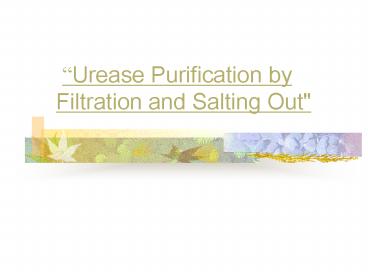Urease Purification by Filtration and Salting Out" - PowerPoint PPT Presentation
1 / 20
Title:
Urease Purification by Filtration and Salting Out"
Description:
We have to confirm the existence of the protein. by activity at each step. ... and chemical properties such as size, charge, hydrophobicity and affinity. ... – PowerPoint PPT presentation
Number of Views:369
Avg rating:3.0/5.0
Title: Urease Purification by Filtration and Salting Out"
1
Urease Purification by
Filtration and Salting Out"
2
Overview
- Introduction
- Scheme of process
- Method of purification
- Quantity and quality
3
Introduction
- Intracellular/exracellular protein
- Check the existence of protein by activity
- Cell distruption
- Purification
- Filtration
- Salting out(Ammonium sulfate precipitation)
- Other methods
4
- Quantity
- Lowry method
- Activity
- Other methods
- Quality
- Chromatography
- Electrophoresis
- Summary
5
1. Scheme of process
- We have to confirm the existence of the protein
- by activity at each step.
Fig. 1. Checking the existence of the protein.
6
2. Activity
- Correlation with purity and concentration.
- Substrate and enzyme reaction.
- Expressed in activity unitUorU/mg.
- Check the activity with color change.
- When enzyme exists, the color changes from
red to pink.
7
3. Protein Extraction
- Table. 1. Cell disruption methods for various
tissues.
8
- Sonication
- Disrupts tissue by creating vibrations which
cause mechanical shearing of the cell wall.
Fig. 2. Sonicator
9
4. Purification
- Filtration
- Protein solution through a membrane which retains
the protein of interest. - This method is less likely to cause denaturation.
Fig. 3. Concentration of a protein solution
using the Amicon Concentration
system.
10
- Salting out
- (Ammonium sulfate precipitation)
- Proteins tend to aggregate and precipitate from
solution. - Different proteins precipitate at different salt
concentration. - Important factor pH, temperature, protein
purity. - Making to X solution from Xo solution.
- g 515(X-Xo0/100-0.27x
11
Table. 2. Ammonium sulfate precipitation table.
12
- Other methods
- - Dialysis, polyethylene glycol precipitation,
Ion exchange chromatography and so on.
13
5. Quantity
- Lowry method
- A combination of the copper reaction with peptide
bond. - Folin-Ciocalteau reagent with phenol was found to
give blue color with proteins. - There are many modified methods.
- Obtain a value by spectrophotometer.
14
- Activity
- The total activity(U) is in proportion to the
total protein(mg or µg). - Using a spectrophotometer, we can check the
activity.
15
- Other methods.
- - Bradford Assay, bicinchoninic acid assay,
Kjeldahl method, Warburg-Christian method etc.
16
6. Quality
- Chromatography
- -Accomplished by the physical and chemical
properties such as size, charge, hydrophobicity
and affinity.
17
- Gel filtration chromatography separates
proteins by size, column packed with porous
polymeric bead.
Fig. 4. Mechanism of gel filtration.
18
- Ion exchange chromatography proteins bind to
ion exchangers by electrostatic force between the
proteins surface and the charged group of
exchangers
Fig. 5. Schematic of cation exchange
mechanism.
19
- Electrophoresis
- separates proteins based on their size and
charge. - SDS-PAGE denaturing condition
- Native gel electrophoresis - nondenaturing
condition
20
7.Summary
- Urease is a intracellular protein.
- Most of enzymes size is greater than 300kDa.
- Most of enzyme precipitate between 60 to 80
ammonium sulfate. - Activity is 0.86 APU.
- Recovery is 30.































